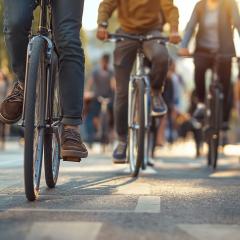With summer on the horizon, many of us look forward to enjoying some sun, surf and sand. But beyond your well-earned holiday break, oceans play an essential role in life regeneration.
They cover 70% of the Earth’s surface, helping to feed us, regulate our climate and generate most of our oxygen, as the United Nations Environment Programme explains.
The threats posed to oceans by human-led activities and incidents are well documented, yet it can be difficult to connect these mega issues with impacts and actions in our everyday lives.
Beaches may be one of our best opportunities, according to Dr Daniel Harris, a senior lecturer and researcher in geography and marine science at UQ’s School of the Environment.
“When we think about challenges such as rising sea levels, coral bleaching or climate change, it can all seem quite abstract and disconnected to our day-to-day experience,” Dr Harris says.
“Beaches remind us of why it all matters – and perhaps re-motivate us to want to do more.”

Dr Amelia Wenger, a senior research fellow specialising in interdisciplinary conservation solutions for water pollution at the School of the Environment, focuses on translating science into practical ideas.
“It’s hard not to feel overwhelmed when you talk about some of the bigger issues facing our planet.
“But there are lots of things you can do in your everyday life to help look after our oceans,” she says.
Dr Wenger and Dr Harris share their top tips.
- Return unused medication to the chemist. Next time you have a half empty bottle of antibiotics, or a packet of use-by pills, take them back to your local pharmacy instead of tipping them down the sink or toilet. “Many chemists in Australia will accept unused medication and dispose of it safely so it doesn’t end up flushed away down the toilet, where it is not necessarily able to be removed via wastewater treatment,” says Dr Wenger.
- Look for phosphorus-free laundry detergent and dishwasher tablets (NP). Phosphorus is an essential nutrient for sustaining life, including in our oceans. Put simply, it helps things to grow and is a common ingredient in many fertilisers. It is also used in some detergents, as it can help break down chemical elements to make water ‘softer’ and better at washing. On the other hand, too much phosphorous in our water causes an imbalance of microorganisms, which can have damaging effects on the entire marine ecosystem. While some countries ban phosphorus in detergent, Australia has different labels to help consumers choose. “Look for laundry detergent with the label ‘NP’ (no phosphorus),” Dr Wenger advises. “It’s about improving the quality of water that goes into wastewater treatment plants. The more we can avoid it getting into wastewater in the first place, the better the plant will be at removing additional phosphorus.”
- Be aware of what you put on your garden. Fertilisers and pesticides may contain an array of chemicals that are harmful to oceans and the greater environment. Although commercial agriculture is regulated in terms of what and how many chemicals can be used, home gardeners are less so (within the boundaries of commercially available products). Chemicals in your home garden can cause direct issues when rain or watering causes run-off that finds its way into the ocean – even if you live a few hours away from the coastline. So, try to avoid chemical products or, if you must use them, stick to the recommended dosage on the label, Dr Wenger says.
- Avoid single-use items (paper or plastic). “We’re in the midst of a transition from single-use plastics to single-use paper,” Dr Wenger observes. “As the accumulation of plastics and microplastics cause untold harm for our oceans, this is positive on one front. But really, we need to work towards avoiding single-use items altogether,” she emphasises. “You might choose something like a straw or a fork because it’s biodegradable, but it very likely still needs to be processed in specialist facilities. If it ends up in landfill it can actually create more greenhouse gas emissions than a plastic straw would. If you can, choose re-usable items instead.” Or, you could consider doing without.
- Avoid food waste. Food waste is one of everyday households’ most regular contributors to landfill – and therefore to greenhouse gas emissions, which are responsible for rising sea levels, Dr Wenger notes. “Protecting our oceans is part of the bigger picture,” she says. Try to introduce strategies into your kitchen and daily habits to reduce food waste. And consider urging your local council to introduce food scrap bins for composting, in addition to green waste bins, she suggests. “Australia needs to meet its carbon emissions goals and food waste is a huge target. But if people don’t ask, local councils won’t necessarily prioritise this kind of initiative.”
- Join a coastal community group. Queensland has a lot of coast line to look after and resources can be spread quite thinly. Community groups have an opportunity to really help their local council with coastline management, Dr Harris says. “People may not realise it, but there isn’t a nationwide coastline management approach. So, while that causes challenges, it does mean people can make a real difference by simply coming together to either take practical action or try to influence conservation outcomes. For example, local coastal land care groups might run volunteer projects such as revegetating sand dunes or hosting regular clean-ups, both of which can deliver numerous benefits for coastlines and oceans in their area.”
- Embrace coastal citizen science. Many researchers also recommend that local residents become part of the solution by embracing citizen science. This can be done formally, by joining community beach monitoring projects such as the global CoastSnap, Dr Harris suggests. But it can also be done less formally, by simply taking photos of erosion or other coastal issues, and tagging and uploading them to social media, especially in the aftermath of storms or other weather incidents (once it is safe to do so), Dr Harris says. “You might be surprised at the usefulness of that kind of data,” he adds. “Not only for the research itself, but also as a way of sharing information to local councils, which generally respond to priorities expressed by their constituents.”

Both Dr Harris and Dr Wenger are involved in diverse research to investigate and help protect our oceans and coastlines. Dr Wenger holds a joint position with the Wildlife Conservation Society as lead of their new Water Pollution Initiative, which focuses on helping countries around the world to implement water pollution mitigation strategies. Dr Harris studies beaches, coral reefs and coastlines. He focuses on gathering data, developing tools and providing coastal analysis to help governments, communities and commercial operators navigate the challenges of climate change.



